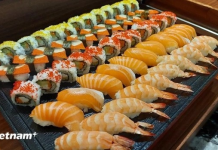These exclusive images are currently on display at the “Sword Lake: East-West Intersection” exhibition at the Hoan Kiem Lake Cultural Information Center until October 31.
Over 100 documents, materials, photographs, design drawings, and planning maps offer a comprehensive view of Hanoi’s transformation from the early 19th century to the mid-20th century.
The documentary photos capture the landscape and daily life of Hanoi, evoking nostalgic memories of the past days at Hoan Kiem or Sword Lake.
Sword Lake, which is the remaining part of the ancient Nhi Ha River, is a renowned landmark of the capital. It is surrounded by Hang Khay – Le Thai To – Dinh Tien Hoang streets.
Thanks to its prime location, this area served as a significant intersection connecting the architectural and cultural aspects of the East and the West.
By the end of the 19th century, iconic French-style buildings such as the Post Office, City Hall, Embassy, Indochina Bank, and others were constructed. These majestic buildings still stand strong and remain significant after almost a century.
| Sword Lake, a remnant of the ancient Nhi Ha River, is the capital’s landmark. |
| In 1884, Sword Lake was still a rural pond with footbridges installed. There were also various small huts and narrow lanes around the area. |
| Under the planning of the French, the landscape around Sword Lake has changed drastically. A dense system of trees is planted around the lake. Meanwhile, the exploitation of the lake surface for tourism started to be a concern. |
| A tram going through Hoa Phong Tower, the only remnant of the demolished Bao An Pagoda on the shore of Sword Lake. |
| Dong Kinh Nghia Thuc Square is the intersection of many tram lines. |
| The scenery of Sword Lake, Ngoc Son Temple, and The Huc Bridge in the old days. |
| Francis Garnier Avenue or today’s Dinh Tien Hoang Street in 1900. |
| Between 1884 and 1886, numerous luxury fashion shops, bookstores, and pharmacies were opened in the commercial streets around Sword Lake, including Trang Tien and Hang Khay streets. |
| People cross The Huc Bridge to Ngoc Son Temple. The bridge collapsed on the night of February 13, 1953. It was rebuilt in early 1954 thanks to donations from local and French citizens. |
| Ba Kieu Temple, located east of Sword Lake, was built in the early 19th century under the regime of King Le Than Tong (1619-1628) to worship Holy Mother Lieu Hanh and her two maids Quynh Hoa, Que Hoa. |
| Thuy Ta House or “a pavilion over the water”, built in 1936, is the only building on the shore of Hoan Kiem Lake. After 1954, it was converted into a restaurant. |
| On the left side of Chavassieux Square (now Dien Hong or Toad Flower Garden) is the famous Metropole Hotel and on the right side is the Tonkin Governor’s Palace. |
| Paul Bert Square (now Ly Thai To Flower Garden) and the former Hanoi Treasury Building. |
















